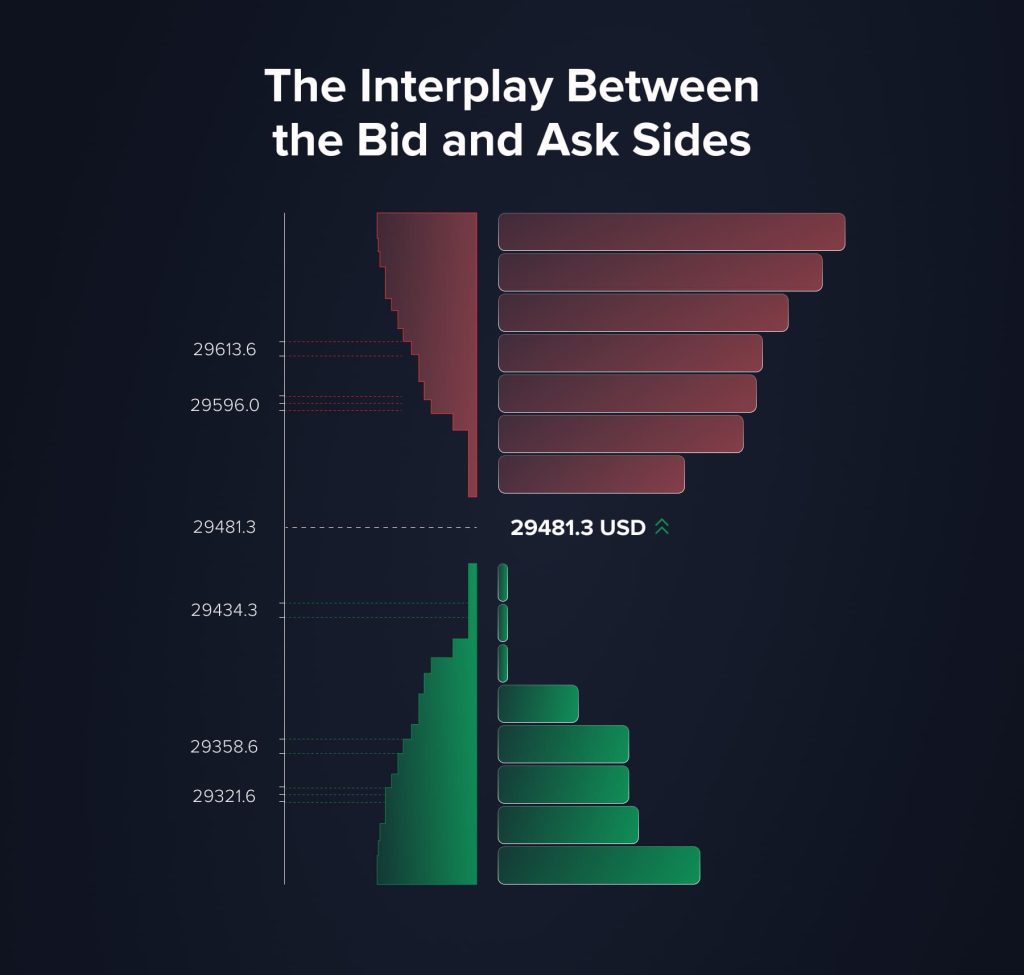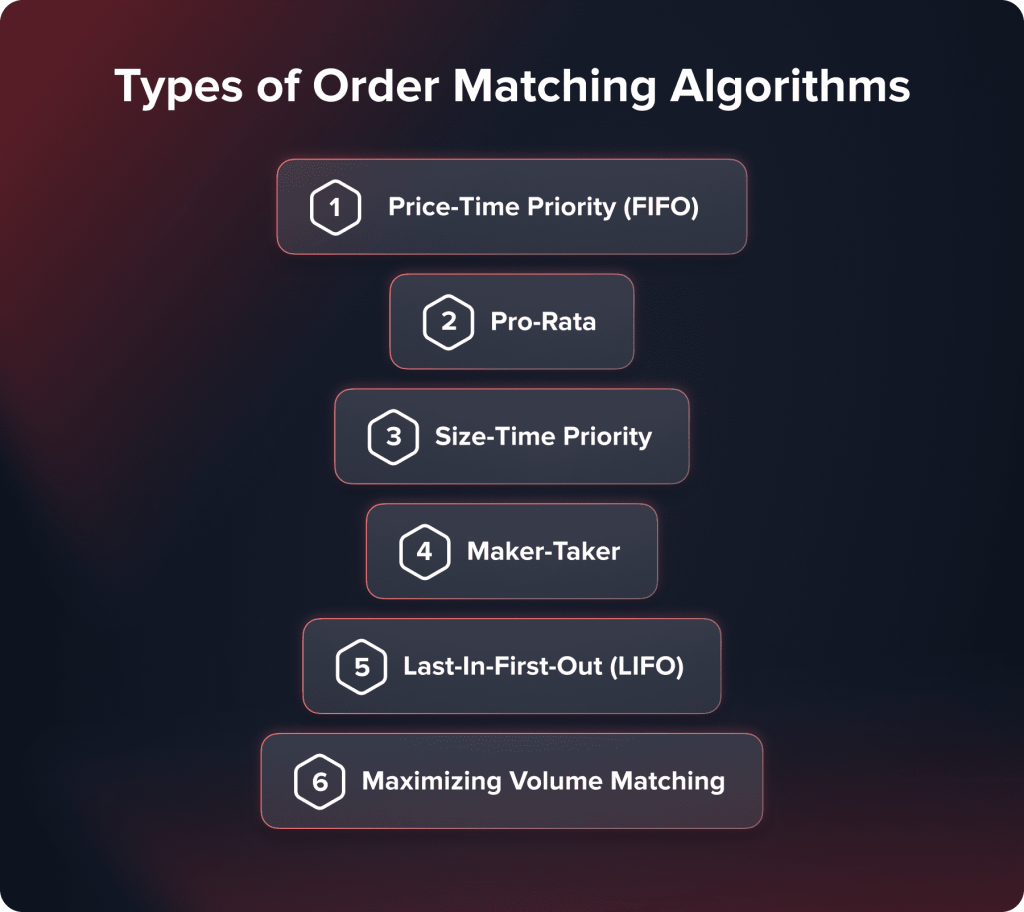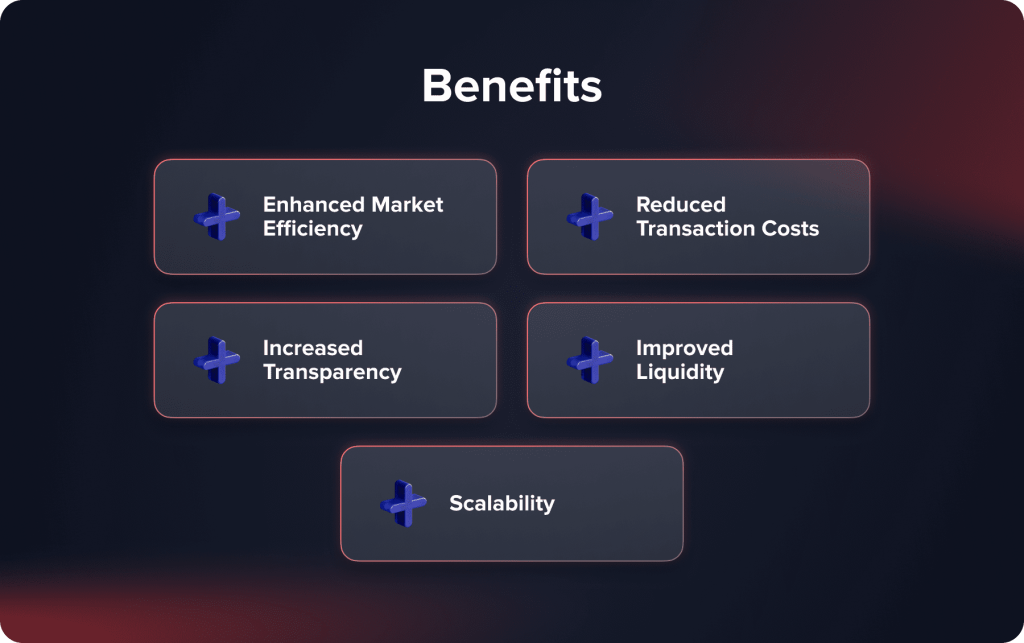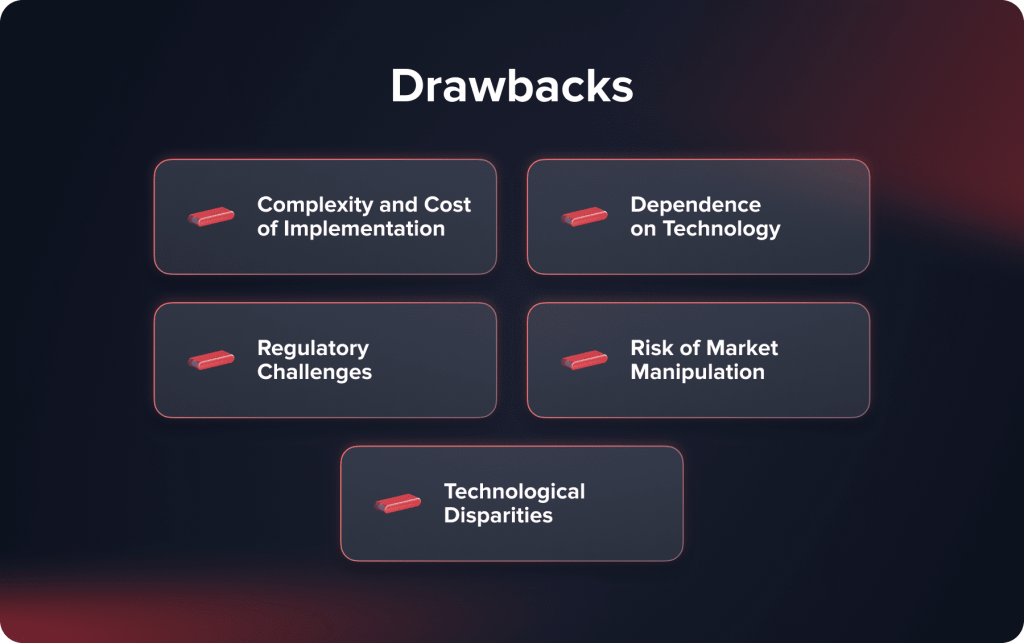
Công cụ khớp lệnh: Nó là gì và hoạt động như thế nào?
Mục lục
Trong thế giới giao dịch tài chính tốc độ cao, công cụ khớp lệnh là công nghệ cốt lõi hỗ trợ các sàn giao dịch truyền thống và hiện đại. Những hệ thống tinh vi này đảm bảo các giao dịch được thực hiện liền mạch và hiệu quả, đóng vai trò then chốt cho thị trường tài chính toàn cầu. Hiểu được cách thức hoạt động của công cụ khớp lệnh là điều cần thiết cho bất kỳ ai tham gia vào thị trường tài chính, từ nhà giao dịch đến người vận hành sàn giao dịch. Bài viết này đi sâu vào cơ chế hoạt động của công cụ khớp lệnh, khám phá vai trò then chốt của chúng trong việc xác định giá và các yếu tố quan trọng cần xem xét khi triển khai hoặc lựa chọn công cụ khớp lệnh cho nền tảng giao dịch .
Công cụ khớp lệnh là gì?
Công cụ khớp lệnh là công nghệ nền tảng của các sàn giao dịch tài chính, hoạt động như một phòng máy tinh vi, nơi các lệnh mua và bán được ghép nối. Hệ thống phần mềm này rất quan trọng đối với hoạt động của các thị trường cổ phiếu, hàng hóa, tiền điện tử và phái sinh. Nó xử lý và khớp lệnh từ những người tham gia thị trường dựa trên các thuật toán phức tạp, do đó cho phép thực hiện giao dịch liền mạch. Cơ chế này hỗ trợ giao dịch hàng ngày với khối lượng tài sản khổng lồ và đảm bảo thị trường hoạt động hiệu quả và minh bạch.
Về bản chất, vai trò của công cụ khớp lệnh là tạo ra một môi trường nơi thanh khoản thị trường - tức là khả năng dễ dàng mua hoặc bán tài sản ở mức giá ổn định - được duy trì thông qua việc khớp lệnh liên tục. Bằng cách kết nối người mua và người bán một cách hiệu quả mà không có sự chênh lệch giá đáng kể, công cụ khớp lệnh duy trì tính toàn vẹn của thị trường tài chính và tạo điều kiện cho việc thực hiện giao dịch công bằng và có trật tự.
Công cụ khớp lệnh so với Hệ thống quản lý đơn hàng (OMS)
Cả công cụ khớp lệnh và hệ thống quản lý lệnh (OMS) đều là những phần quan trọng của giao dịch điện tử, nhưng mỗi phần đều có vai trò riêng.
Công cụ khớp lệnh là yếu tố then chốt giúp giao dịch diễn ra. Nó ngay lập tức ghép nối các lệnh mua và bán theo các quy tắc được thiết lập sẵn và thực hiện việc này theo thời gian thực, thường chỉ trong vài mili giây. Công cụ này kết nối trực tiếp với sổ lệnh và các nguồn thanh khoản của sàn giao dịch để hoàn thành công việc.
Mặt khác, Hệ thống Quản lý Lệnh (OMS) đảm nhiệm các công việc hậu trường. Hệ thống này xử lý việc tạo, thay đổi và gửi lệnh đến các địa điểm khác nhau. Các nhà môi giới, công ty quản lý tài sản và nhà đầu tư lớn sử dụng OMS để hợp lý hóa quy trình giao dịch, đảm bảo tuân thủ và quản lý danh mục đầu tư của họ. Không giống như các công cụ khớp lệnh, OMS không thực sự thực hiện giao dịch.
Sau đây là một so sánh nhanh:
| Tính năng | Công cụ khớp lệnh | OMS |
| Chức năng | Xử lý và khớp lệnh mua và bán. | Xử lý và chỉ đạo các đơn hàng thông qua các hệ thống khác nhau. |
| Người dùng | Các sàn giao dịch, nhà môi giới và nền tảng giao dịch. | Các công ty đầu tư, nhà môi giới và nhà quản lý tài sản. |
| Ưu tiên tốc độ | Thực hiện cực nhanh chỉ trong vài micro giây. | Không cung cấp thông tin cập nhật theo thời gian thực; Tập trung vào việc quản lý đơn hàng và theo dõi. |
| Tích hợp với | Sổ lệnh, nhóm thanh khoản và công cụ định giá. | Hệ thống danh mục đầu tư, công cụ tuân thủ và ứng dụng văn phòng. |
Ai sử dụng công cụ tìm kiếm khớp lệnh?
Công cụ khớp lệnh rất cần thiết cho thị trường tài chính ngày nay. Các nhóm giao dịch khác nhau sử dụng chúng dựa trên nhu cầu và thiết lập của họ:
- Sàn giao dịch chứng khoán và hàng hóa - Những nơi này phụ thuộc vào công cụ khớp lệnh siêu nhanh để xử lý giao dịch tốc độ cao, đặc biệt là đối với các nhà đầu tư tổ chức.
- Nền tảng giao dịch tiền điện tử - Các sàn giao dịch tiền điện tử dựa vào các công cụ khớp lệnh để xử lý các lệnh theo thời gian thực, giúp đảm bảo tính thanh khoản trong môi trường biến động - một yếu tố quan trọng trong thành công trong giao dịch tiền điện tử .
- Các công ty giao dịch độc quyền - Các công ty có chiến lược giao dịch riêng thường tạo ra các công cụ khớp lệnh tùy chỉnh để quản lý tốc độ thực hiện giao dịch và xử lý thanh khoản.
- Nền tảng môi giới - đại lý - Các nhà môi giới và đại lý sử dụng công cụ khớp lệnh để khớp lệnh của khách hàng nội bộ hoặc gửi lệnh đến các địa điểm khác một cách hiệu quả.
- Dark Pools & Hệ thống giao dịch thay thế - Các điểm giao dịch ngoài sàn này sử dụng công cụ khớp lệnh cho các giao dịch ẩn danh, thường là khi xử lý số lượng tài sản lớn.
Cho dù là sàn giao dịch công khai hay không gian giao dịch riêng tư, công cụ khớp lệnh đều rất quan trọng để đảm bảo giao dịch diễn ra suôn sẻ và tuân thủ các quy tắc trong nhiều điều kiện thị trường khác nhau.
Cơ chế của một động cơ khớp nối
Đi sâu hơn vào cơ chế hoạt động của công cụ khớp lệnh sẽ thấy vai trò quan trọng của sổ lệnh. Thành phần này ghi lại mọi ý định giao dịch và chủ động định hình động lực thị trường thông qua các cập nhật và tương tác theo thời gian thực giữa người mua và người bán.
Sổ lệnh: Nền tảng của một công cụ khớp lệnh
Các sổ lệnh is the fundamental component of a matching engine, meticulously organizing and displaying all open buy and sell orders for an asset. This real-time, dynamic ledger is categorized by price level and constantly updated as new orders are placed and existing ones are fulfilled or canceled. Các sổ lệnh is structurally divided into two distinct sides:
- Phía đấu thầu: Phần này của sổ lệnh liệt kê tất cả các lệnh mua, được sắp xếp theo mức giá mà người mua sẵn sàng trả, từ cao nhất đến thấp nhất. Phần này phản ánh nhu cầu trên thị trường, với mỗi lệnh ghi rõ mức giá tối đa mà người mua sẵn sàng trả và số lượng mong muốn.
- Phía hỏi: Ngược lại, mặt này liệt kê tất cả các lệnh bán, được sắp xếp theo giá người bán đưa ra, từ thấp đến cao. Mặt này thể hiện nguồn cung trên thị trường, với mỗi lệnh nêu chi tiết mức giá tối thiểu người bán sẵn sàng chấp nhận và số lượng chào bán.

Sự tương tác giữa bên mua và bên bán của sổ lệnh thúc đẩy quá trình khám phá giá. Khám phá giá là cơ chế xác định giá thị trường của một tài sản, về cơ bản là tìm ra mức giá cân bằng tại đó cung gặp cầu. Khi các lệnh được thực hiện và các lệnh mới được đưa vào hệ thống, sổ lệnh sẽ phát triển, phản ánh các điều kiện thị trường mới nhất và do đó, giá mới nhất của tài sản. Sự điều chỉnh liên tục này rất quan trọng đối với tính minh bạch của thị trường, cho phép người tham gia phản ứng dựa trên biến động giá và dòng lệnh theo thời gian thực, có thể nhìn thấy được.
Thuật toán khớp lệnh: Cốt lõi của công cụ

Hiệu quả của một công cụ khớp lệnh được xác định bởi các thuật toán khớp lệnh, được thiết kế để căn chỉnh các lệnh mua và bán từ sổ lệnh theo cách thúc đẩy hiệu quả thị trường. Các thuật toán này hoạt động theo các quy tắc cụ thể để quyết định lệnh nào sẽ được khớp và thực hiện, ảnh hưởng đến tính thanh khoản của thị trường và trải nghiệm giao dịch của người tham gia. Các thuật toán khớp lệnh được sử dụng phổ biến nhất bao gồm:
Ưu tiên giá-thời gian (FIFO)
Thuật toán được áp dụng rộng rãi này ưu tiên các lệnh không chỉ theo giá tốt nhất mà còn theo thời điểm đặt lệnh. Các lệnh ở cùng mức giá được thực hiện theo thứ tự nhận được, do đó có thuật ngữ "Nhập trước, Xuất trước". Phương pháp này đảm bảo tính công bằng và khuyến khích người tham gia thị trường đặt lệnh nhanh chóng, vì lệnh đặt trước sẽ được ưu tiên.
Tỷ lệ thuận
Đặc biệt hữu ích trong các thị trường xử lý khối lượng giao dịch lớn, chẳng hạn như một số hàng hóa hoặc sản phẩm phái sinh, thuật toán Pro-Rata phân bổ lệnh khớp giữa các lệnh có cùng mức giá theo tỷ lệ tương ứng với khối lượng giao dịch. Phương pháp này cân bằng thị trường, cho phép khớp lệnh phù hợp với các lệnh lớn mà không gây quá tải cho sổ lệnh.
Ưu tiên kích thước-thời gian
Tương tự như FIFO, thuật toán này ưu tiên các lệnh không chỉ theo thời gian nhập lệnh mà còn xem xét cả quy mô lệnh. Các lệnh lớn hơn có thể được ưu tiên nếu được đặt đồng thời với các lệnh nhỏ hơn, đặc biệt hữu ích trong các thị trường mà việc xử lý khối lượng lớn một cách hiệu quả là rất quan trọng. Phương pháp này có thể giúp ổn định giá bằng cách đảm bảo các lệnh thị trường lớn không gây ra biến động quá mức.
Người tạo ra-Người lấy
Mô hình này khuyến khích những người tham gia thị trường cung cấp thanh khoản (nhà sản xuất) hoặc lấy đi thanh khoản (người khớp lệnh). Người tạo lệnh thêm lệnh vào sổ lệnh thường được hưởng chiết khấu hoặc giảm phí. Ngược lại, người khớp lệnh loại bỏ thanh khoản bằng cách khớp lệnh hiện có có thể phải trả phí cao hơn. Hệ thống này khuyến khích giao dịch và thanh khoản nhiều hơn, điều này rất quan trọng đối với sức khỏe tổng thể của thị trường. Mô hình này đặc biệt phổ biến trong thị trường tiền điện tử, nơi hiểu các chiến lược giao dịch có thể giúp các nhà giao dịch hưởng lợi từ các ưu đãi thanh khoản.
Vào sau ra trước (LIFO)
Ngược lại với FIFO, thuật toán LIFO ưu tiên các lệnh được đặt gần đây nhất ở một mức giá cụ thể. Điều này có thể có lợi trong môi trường giao dịch diễn biến nhanh, nơi các lệnh mới nhất phản ánh tâm lý thị trường và giá cả hiện tại.
Tối đa hóa việc khớp khối lượng
Một số công cụ khớp lệnh sử dụng thuật toán để tối đa hóa khối lượng giao dịch bằng cách tìm ra mức khớp lệnh lớn nhất có thể giữa các lệnh mua và bán. Phương pháp này có thể trì hoãn việc thực hiện một chút để tổng hợp và khớp lệnh với khối lượng lớn hơn, có khả năng dẫn đến thanh khoản thị trường tổng thể cao hơn và giảm trượt giá.
Mỗi thuật toán phục vụ một mục đích cụ thể và được lựa chọn dựa trên các đặc điểm và nhu cầu riêng của nền tảng giao dịch. Việc lựa chọn thuật toán khớp lệnh rất quan trọng vì nó ảnh hưởng trực tiếp đến tốc độ thực hiện giao dịch, tính công bằng của việc thực hiện giao dịch, tính thanh khoản của thị trường và sự biến động của giá tài sản. Trong môi trường mà việc thực hiện nhanh chóng và ổn định giá là tối quan trọng, việc lựa chọn thuật toán khớp lệnh phù hợp trở thành một quyết định chiến lược có thể ảnh hưởng đáng kể đến sự thành công của nền tảng giao dịch và sự hài lòng của người tham gia.
Sau đây là cái nhìn nhanh về các loại thuật toán khớp lệnh khác nhau và cách so sánh chúng.
| Thuật toán | Cơ sở ưu tiên | Tốt nhất cho | Lợi thế chính |
| Giá-Thời gian (FIFO) | Giá + Thời gian | Sàn giao dịch chứng khoán | Đảm bảo giá cả hợp lý cho những người đặt hàng sớm. |
| Tỷ lệ thuận | Kích thước đơn hàng | Hàng hóa, sản phẩm phái sinh | Phân phối sản phẩm theo kích thước; phù hợp với thị trường lớn. |
| Ưu tiên kích thước-thời gian | Kích thước + Thời gian | Thị trường tổ chức có khối lượng lớn | Đạt được sự cân bằng tốt giữa hiệu quả và công bằng cho các giao dịch lớn. |
| Người tạo ra-Người lấy | Vai trò thanh khoản | Tiền điện tử | Tăng cường tính thanh khoản bằng cách thưởng cho những người tham gia thụ động |
| Vào sau, ra trước (LIFO) | Hoạt động gần đây | Thị trường chuyển động nhanh | Phản ứng với xu hướng thị trường hiện tại khi quyết định nên làm gì tiếp theo. |
| Tối đa hóa việc khớp khối lượng | Khối lượng tổng hợp | Môi trường trượt thấp | Giảm thiểu sự trượt giá bằng cách tập trung vào khối lượng giao dịch thay vì tốc độ giao dịch. |
Tác động của thuật toán khớp
Các thuật toán khớp lệnh ảnh hưởng đáng kể đến động lực của thị trường tài chính bằng cách đảm bảo thực hiện giao dịch một cách có trật tự và hiệu quả. Các thuật toán này rất quan trọng để thiết lập một môi trường giao dịch công bằng, nơi các lệnh được khớp hiệu quả theo các quy tắc được xác định trước. Ví dụ, các thuật toán như FIFO và Pro-Rata tạo điều kiện cho sự minh bạch và công bằng, đồng thời ngăn chặn sự thống trị thị trường của bất kỳ bên tham gia nào, từ đó bảo vệ thị trường khỏi các thao túng tiềm ẩn và đảm bảo một sân chơi bình đẳng cho tất cả các nhà giao dịch.
Hơn nữa, bằng cách tối ưu hóa việc thực hiện giao dịch để tăng cường thanh khoản và giảm biến động giá, các thuật toán này góp phần tạo nên điều kiện thị trường ổn định và dễ dự đoán hơn. Sự ổn định này rất quan trọng để thu hút lượng người tham gia lớn hơn, tăng cường thanh khoản hơn nữa và làm sâu sắc thêm thị trường. Việc áp dụng chiến lược các thuật toán này hỗ trợ các hoạt động giao dịch cốt lõi, củng cố tính toàn vẹn hoạt động của thị trường và thúc đẩy sức khỏe tổng thể của thị trường.
Bằng cách khớp lệnh mua và bán hiệu quả, các thuật toán khớp lệnh không chỉ xử lý giao dịch; chúng còn định hình đặc điểm của thị trường, tác động đến tính thanh khoản và biến động của thị trường, đồng thời đảm bảo giao dịch luôn dễ tiếp cận và công bằng cho tất cả người tham gia thị trường. Tác động của chúng vượt ra ngoài phạm vi thực hiện giao dịch đơn thuần, đóng vai trò then chốt trong cấu trúc và chức năng tổng thể của thị trường tài chính.
Lợi ích của việc sử dụng công cụ khớp lệnh
Công cụ khớp lệnh đóng vai trò then chốt trong cơ sở hạ tầng giao dịch hiện đại, thúc đẩy hiệu quả và tính minh bạch trên khắp các thị trường tài chính. Việc tích hợp chúng vào các nền tảng giao dịch mang lại nhiều lợi thế, có thể chuyển đổi hoạt động thị trường.

Nâng cao hiệu quả thị trường
Công cụ khớp lệnh cải thiện đáng kể hiệu quả thị trường bằng cách đảm bảo các lệnh được thực hiện nhanh chóng và chính xác. Chúng tự động hóa quy trình khớp lệnh phức tạp, rút ngắn thời gian xử lý lệnh và giúp duy trì thị trường năng động và linh hoạt.
Tăng cường tính minh bạch
Công cụ khớp lệnh tạo ra một môi trường giao dịch minh bạch bằng cách sắp xếp và thực hiện giao dịch một cách có hệ thống. Tất cả người tham gia thị trường đều có quyền truy cập bình đẳng vào thông tin về dòng lệnh và biến động giá, điều này thúc đẩy sự công bằng và xây dựng niềm tin vào thị trường.
Giảm chi phí giao dịch
Việc tự động khớp lệnh giao dịch giúp giảm nhu cầu can thiệp thủ công, từ đó giảm chi phí vận hành liên quan đến giao dịch. Hiệu quả này có thể dẫn đến chênh lệch giá hẹp hơn và ít trượt giá hơn, cuối cùng là giảm chi phí giao dịch cho nhà giao dịch.
Thanh khoản được cải thiện
Công cụ khớp lệnh tạo điều kiện thuận lợi cho giao dịch liên tục bằng cách xử lý hiệu quả khối lượng lớn lệnh mua và bán. Khả năng này rất quan trọng để duy trì tính thanh khoản cao, giúp nhà giao dịch dễ dàng vào và thoát lệnh hơn, và nhìn chung dẫn đến giá cả ổn định hơn.
Khả năng mở rộng
Các công cụ khớp lệnh tiên tiến được thiết kế để mở rộng quy mô khi khối lượng giao dịch tăng lên. Khả năng mở rộng này rất quan trọng đối với các nền tảng giao dịch dự đoán sự gia tăng về số lượng người dùng và hoạt động giao dịch, đảm bảo công cụ có thể xử lý khối lượng công việc lớn hơn mà không ảnh hưởng đến hiệu suất. Các công cụ khớp lệnh có khả năng mở rộng quy mô cũng rất cần thiết cho các nền tảng hướng đến mục tiêu phát triển, chẳng hạn như các nền tảng nhắm mục tiêu đến chiến lược đa dạng hóa nhiều tài sản .
Nhược điểm của việc sử dụng công cụ khớp lệnh
Mặc dù có những ưu điểm đáng kể, công cụ khớp lệnh vẫn tồn tại những thách thức cố hữu và những nhược điểm tiềm ẩn có thể ảnh hưởng đến các nền tảng giao dịch và người tham gia thị trường. Việc hiểu rõ những hạn chế này là rất quan trọng để quản lý rủi ro và đảm bảo hoạt động thị trường ổn định.

Độ phức tạp và chi phí triển khai
Việc triển khai một công cụ khớp lệnh phức tạp có thể rất phức tạp về mặt kỹ thuật và tốn kém. Việc thiết lập ban đầu đòi hỏi đầu tư đáng kể về tiền bạc và thời gian, và có thể phát sinh chi phí liên tục liên quan đến bảo trì và nâng cấp.
Sự phụ thuộc vào công nghệ
Việc phụ thuộc vào công nghệ tiềm ẩn nhiều rủi ro, chẳng hạn như nguy cơ lỗi hệ thống hoặc tấn công mạng. Bất kỳ sự gián đoạn nào cũng có thể dẫn đến việc bỏ lỡ các cơ hội giao dịch và tổn thất tài chính tiềm ẩn, chưa kể đến tổn thất về uy tín có thể xảy ra sau đó.
Thách thức về quy định
Khi công nghệ tài chính phát triển, các yêu cầu pháp lý chi phối chúng cũng tăng theo. Việc đảm bảo một công cụ khớp lệnh tuân thủ tất cả các luật và quy định liên quan có thể là một thách thức, đặc biệt là ở những khu vực có sự giám sát tài chính nghiêm ngặt.
Rủi ro thao túng thị trường
Mặc dù các công cụ khớp lệnh thúc đẩy hiệu quả thị trường, chúng cũng cần có các biện pháp bảo vệ mạnh mẽ để ngăn chặn thao túng thị trường, chẳng hạn như nhồi nhét giá hoặc giả mạo. Nếu không được kiểm tra đầy đủ, các hệ thống tự động có thể bị lợi dụng bởi các nhà giao dịch vô đạo đức.
Sự chênh lệch về công nghệ
Không phải tất cả người tham gia thị trường đều có quyền truy cập ngang nhau vào các công nghệ khớp lệnh tiên tiến, dẫn đến sự chênh lệch về sức mạnh giao dịch và hiệu quả. Các nhà giao dịch nhỏ hơn hoặc kém tiên tiến về công nghệ có thể gặp bất lợi so với các đơn vị lớn hơn, được trang bị tốt hơn.
Tóm tắt ưu và nhược điểm
| Ưu điểm | Nhược điểm |
| Hiệu quả thị trường tốt hơn: Nó tự động thực hiện giao dịch và tăng tốc độ xử lý lệnh. | Triển khai phức tạp và tốn kém: Cần đầu tư đáng kể vào việc thiết lập, bảo trì và nâng cấp. |
| Minh bạch hơn: Việc xem sổ lệnh theo thời gian thực giúp tạo ra giao dịch công bằng và đáng tin cậy. | Sự phụ thuộc vào công nghệ: Dễ bị lỗi hệ thống, ngừng hoạt động và bị đe dọa mạng. |
| Giảm chi phí giao dịch: Tự động hóa giúp giảm nhu cầu làm việc thủ công, giúp giảm thiểu tình trạng trượt giá và chênh lệch giá. | Thách thức về quy định: Cần phải theo kịp các luật và quy định tài chính thay đổi. |
| Thanh khoản tốt hơn: Giúp bạn dễ dàng xử lý các đơn hàng lớn, giúp bạn ra vào thị trường một cách suôn sẻ. | Rủi ro thao túng thị trường: Giống như việc giả mạo hoặc nhồi nhét trích dẫn, nếu không có biện pháp bảo vệ nào được áp dụng. |
| Khả năng mở rộng: Nó có thể xử lý nhiều giao dịch và người dùng hơn khi số lượng tăng lên. | Khoảng cách công nghệ: Có thể gây tổn hại cho các nhà giao dịch nhỏ không có quyền truy cập vào internet tốc độ cao và hệ thống. |
Những cân nhắc chính khi lựa chọn công cụ khớp lệnh
Việc lựa chọn công cụ khớp lệnh phù hợp là một quyết định quan trọng đối với bất kỳ nền tảng giao dịch nào, ảnh hưởng trực tiếp đến khả năng hoạt động hiệu quả và đáp ứng nhu cầu của người dùng. Việc lựa chọn này bao gồm một số cân nhắc chính, mỗi cân nhắc cần được đánh giá cẩn thận để đảm bảo công cụ hỗ trợ nhu cầu hiện tại cũng như sự phát triển và mở rộng trong tương lai của nền tảng. Trong bài viết này, chúng tôi sẽ đi sâu hơn vào các yếu tố thiết yếu cần xem xét khi lựa chọn công cụ khớp lệnh.
Khả năng tương thích với các loại tài sản
Khi lựa chọn công cụ khớp lệnh, điều quan trọng là phải đảm bảo nó hỗ trợ các loại tài sản cụ thể mà nền tảng giao dịch của bạn cung cấp. Khả năng tương thích của các loại tài sản khác nhau giữa các công cụ khớp lệnh; một số được chuyên biệt hóa và được thiết kế để xử lý các loại tài sản cụ thể như cổ phiếu, hàng hóa hoặc tiền điện tử, trong khi một số khác linh hoạt hơn. Công cụ khớp lệnh đa tài sản đặc biệt có lợi cho các nền tảng muốn cung cấp nhiều lựa chọn giao dịch đa dạng. Công cụ khớp lệnh đa tài sản lý tưởng cho các nền tảng có kế hoạch hỗ trợ các công cụ như REIT, quyền chọn và tiền điện tử . Các công cụ này được xây dựng để tạo điều kiện giao dịch nhiều loại tài sản khác nhau mà không cần nhiều hệ thống, đơn giản hóa hoạt động và có khả năng giảm chi phí.
Chỉ số hiệu suất: Độ trễ và thông lượng
Hiệu suất của một công cụ khớp lệnh chủ yếu có thể được đánh giá thông qua hai chỉ số: độ trễ và thông lượng. Độ trễ đề cập đến thời gian cần thiết để thực hiện một lệnh sau khi lệnh được đặt. Các hệ thống có độ trễ thấp rất quan trọng trong giao dịch tần suất cao Trong môi trường giao dịch tự động, nơi các lệnh được thực hiện tính bằng mili giây hoặc micro giây. Các hệ thống này giúp nhà giao dịch tận dụng các cơ hội thị trường rất ngắn hạn. Mặt khác, thông lượng - số lượng lệnh mà hệ thống có thể xử lý trong một khung thời gian nhất định - đặc biệt quan trọng đối với các nền tảng tập trung vào bán lẻ hoặc các nền tảng giao dịch khối lượng lớn. Các nền tảng như vậy phải đảm bảo rằng hệ thống có thể quản lý khối lượng giao dịch lớn một cách hiệu quả, đặc biệt là trong giai đoạn thị trường hoạt động mạnh, mà không bị chậm lại hoặc sập.
Bảo mật và Độ tin cậy
Bảo mật là yếu tố tối quan trọng trong bất kỳ hệ thống giao dịch tài chính nào. Một công cụ khớp lệnh phải tích hợp các biện pháp bảo mật mạnh mẽ để bảo vệ chống lại vi phạm dữ liệu, truy cập trái phép và tấn công mạng. Các biện pháp này có thể bao gồm các giao thức mã hóa tiên tiến, kiểm tra bảo mật thường xuyên và tuân thủ các tiêu chuẩn an ninh mạng quốc tế. Độ tin cậy của công cụ khớp lệnh cũng quan trọng không kém. Hậu quả tài chính của việc ngừng hoạt động có thể rất đáng kể, không chỉ về việc mất cơ hội giao dịch mà còn về khả năng gây tổn hại đến danh tiếng của nền tảng. Do đó, việc lựa chọn một công cụ khớp lệnh nổi tiếng với cơ chế hoạt động liên tục và dự phòng là rất quan trọng để xử lý các sự cố bất ngờ.
Phần kết luận
Công cụ khớp lệnh là nền tảng của bất kỳ nền tảng giao dịch nào, đảm bảo thị trường hoạt động hiệu quả, công bằng và minh bạch. Chúng là những hệ thống phức tạp, đòi hỏi sự cân nhắc kỹ lưỡng về chức năng, hiệu suất và bảo mật. Cho dù bạn vận hành một sàn giao dịch truyền thống hay một sàn giao dịch tiên tiến, nền tảng giao dịch tiền điện tử Việc lựa chọn công cụ khớp lệnh có thể quyết định cơ bản sự thành công của sàn giao dịch. Khi công nghệ phát triển, những công cụ này cũng sẽ phát triển theo, tiếp tục định hình lại bối cảnh thị trường tài chính.
FAQ
Sổ lệnh hiển thị danh sách các lệnh mua và bán theo thời gian thực cho một tài sản, được sắp xếp theo giá. Công cụ khớp lệnh là phần mềm tiếp nhận các lệnh đó và thực hiện giao dịch dựa trên các quy tắc đã đặt. Trong khi sổ lệnh hiển thị những gì mọi người muốn mua hoặc bán, công cụ khớp lệnh quyết định cách các lệnh đó được khớp.
Đối với các sàn giao dịch tiền điện tử, mô hình Maker-Taker thường được sử dụng vì nó thúc đẩy tính thanh khoản. Khi kết hợp với mô hình Ưu tiên Giá-Thời gian (FIFO), nó giúp giao dịch diễn ra nhanh chóng và công bằng, điều này rất quan trọng trong thế giới tiền điện tử đầy biến động.
Độ trễ là khoảng thời gian giữa lúc đặt lệnh và thời điểm lệnh được thực hiện. Trong giao dịch tần suất cao, ngay cả những độ trễ nhỏ cũng có thể gây ảnh hưởng lớn. Độ trễ thấp hơn đồng nghĩa với việc nhà giao dịch có thể phản hồi dữ liệu thời gian thực tốt hơn, giảm thiểu trượt giá và thực hiện giao dịch tốt hơn.
Đúng, một số hệ thống giao dịch dựa trên blockchain sử dụng công cụ khớp lệnh phi tập trung, đặc biệt là trong các sàn giao dịch phi tập trung (DEX). Tuy nhiên, chúng thường gặp nhiều vấn đề hơn về khả năng mở rộng và độ trễ so với các hệ thống tập trung, khiến chúng kém lý tưởng hơn cho giao dịch tần suất cao.
Đã cập nhật:
11 tháng 6, 2025



